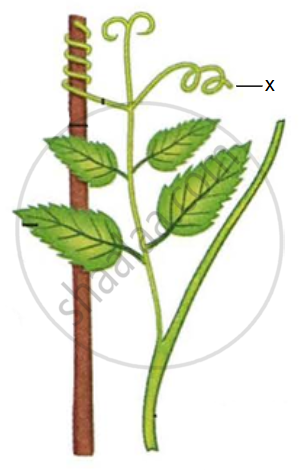Advertisements
Advertisements
प्रश्न
Ali has some pea plants in his garden which need a support to grow as seen in the picture given below:

- Name the phenomenon depicted by the shoot in the given figure.
- Define the above phenomenon.
- Write the name of the part marked X.
उत्तर
- Thigmotropism. Tendrils coiling towards objects they come into contact with show thigmotropism.
- In plants, thigmotropism is a tropic movement in response to an external stimulus, sometimes referred to as a contact stimulus.
- The part marked X is Leaf Tendril.
APPEARS IN
संबंधित प्रश्न
What does a tendril do in response to the touch of a support? What is this phenomenon known as?
Distinguish between tropic movements and nastic movements in plants. Give examples to illustrate your answer.
Higher Order Thinking Skill.
There are 3 plants A, B and C. The flowers of A open their petals in bright light during the day but closes when it gets dark at night. On the other hand, the flowers of plant B open their petals at night but closes during the day when there is bright light. The leaves of plant C fold up and droop when touched with fingers or any other solid object.
- Name the phenomenon shown by the flowers of plant A and B.
- Name one plant each which behaves like the flowers of plant A and B.
- Name the phenomenon exhibited by the leaves of plant C.
- Name the plant which behaves like the leaves of plant 'C'?
Assertion: Plants do have a nervous system for control and coordination.
Reason: Plants use electrochemical means to convey information from cell to cell.
The movement of sunflower in accordance with the path of sun is due to
The plant part which exhibits negative geotropism is ______.
Plants exchange gases ______ continuously through these stomata.
Arrange and rewrite the terms in the group in the correct order so as to be in a logical sequence, beginning with the term that is underlined.
Apical meristem, Positive phototropism, Auxins, Cell elongation.
Growth of root towards water is ______.
Name the stimulus which causes the following movement in plant:
Hydrotropism
